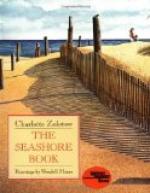5. Why do these two plants have such thin roots?
LESSON VII.
FLOWER-LIKE ANIMALS.
The prettiest of the creatures of the shore is the Sea Anemone. No one can see it without being reminded of a flower, an Aster or Daisy, with a thick stalk and many coloured petals; but, knowing how it is made, and how it lives, we place it in the Animal Kingdom, though among the lowliest members of that Kingdom. It is a cousin of that strange creature, the Jelly-fish, which we shall look at in another lesson.
[Illustration: SEA ANEMONE.]
When the tide falls, you can walk among the rocks and pools by the sea, and find Anemones in plenty. They are fixed to the rocks. Some are under the ledges, out of sight, others are low down, half buried in the wet sand; and others are on the sides of the rocks, looking like blobs of green, brown, or red jelly. Feel one of them. It is slimy, and rather firm, not so soft and yielding as the Jelly-fish. You cannot easily pull it from the rocks without harming it; but you will find other Anemones on stones and shells; and these you can put in a jar of sea-water, with some weed, and carry home to examine later on.
When covered with sea-water the ugly blobs of jelly open out like beautiful flowers. In some places along our coast the floor of the sea is like a flower garden, gay with thousands of coloured Anemones.
Those little “petals” are really tentacles, used for catching and holding food. We will use a shorter word and call them feelers. They are set in circles round the top of the Anemone, and there are many of them. The Daisy Anemone, for instance, has over seven hundred feelers. Each feeler can be moved from side to side, and can also be tucked away, out of sight and out of danger; but, when hungry, the animal spreads them widely, for, as we shall see, they are the net in which it catches its dinner.
The whole body of the Anemone is like two bags, one hanging inside the other. The space between the two bags is filled with water. The feelers are hollow tubes which open out of this space; so they, too, are filled with water.
[Illustration: CRUSTACEA.
1. THE LARVA OF A LEAF-BODIED CRUSTACEAN CALLED PHYLLOSOMA.
2. A PRAWN-LIKE CREATURE, SHOWING THE FRONT LIMBS THAT ARE USED FOR GRASPING PREY.
3. A CRAB.
4. THIS IS A SHRIMP-LIKE CREATURE CALLED CUMA SCORPIOIDES.]
The Anemone can press the water into them, and so force them to open out. In rather the same way you can expand the fingers of a glove by forcing your breath into them. The Anemone, you see, can open or close just as it pleases.
What does it eat, and how does it find food? Perhaps you have watched an open Anemone in a pool, or in a glass tank, and seen it at its meals. A small creature swims near, and touches one of the feelers. Instead of darting away, it appears to be held still; and then other feelers bend towards it and hold the victim. Then they are all drawn to the centre of the Anemone, carrying their prey with them; and the feelers, prey and all, are tucked out of sight.




